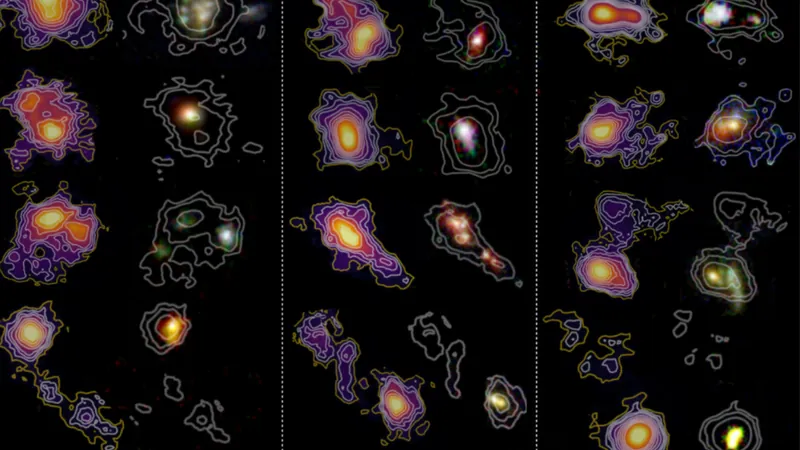
Unveiling the Universe's First Galaxies: ALMA Acts as a Cosmic Time Machine!
2025-07-07
Author: Jacob
A Glimpse into Cosmic History
Astronomers have transformed the Atacama Large Millimeter/submillimeter Array (ALMA) into a groundbreaking time machine, allowing us to travel back to just one billion years after the Big Bang. This pioneering exploration has unveiled hidden structures in some of the universe's very first galaxies, offering insights into how today’s cosmos—including our own Milky Way—evolved.
The Power of CRISTAL
Conducted under the CRISTAL survey (CII Resolved ISM in Star-forming galaxies with ALMA), researchers focused on 39 representative star-forming galaxies from the universe’s infancy, approximately 13.8 billion years ago. Their work was significantly enhanced through collaborations with the James Webb Space Telescope (JWST) and Hubble, zeroing in on galaxies shortly after the Big Bang.
According to CRISTAL's lead investigator, Rodrigo Herrera-Camus, "Thanks to ALMA's unmatched sensitivity and resolution, we can explore the intricate internal structures of these early galaxies like never before. CRISTAL is illuminating the formation of early galactic disks, the emergence of stars in colossal groups, and the impact of gas on the galaxies we recognize today."
Mapping Ancient Structures
The CRISTAL discoveries stemmed from ALMA's ability to monitor a specific emission of ionized carbon atoms in cold interstellar gas, known as the [CII] line emission. This emission acts as a vital marker for cold gas and dust, enabling the team to craft a detailed cosmic map of interstellar material in these primordial galaxies.
Remarkably, this cosmic mapping revealed that stars were forming in massive clusters, some spanning several thousand light-years. Additionally, in many of the observed galaxies, the [CII] emission spread far beyond the visible stars, suggesting an abundance of cold gas either ready to birth new stars or potentially being expelled by powerful winds from newborn stars, showcasing a dynamic star-forming environment.
Many galaxies exhibited a rotation that hints at the evolutionary process leading to their eventual flattening into disk-like formations, the very precursors to spiral galaxies like our Milky Way.
Spotlight on Two Extraordinary Galaxies
Among the 37 observed galaxies, two have emerged as particularly fascinating.
The standout, CRISTAL-13, is enveloped in dense dust clouds that obscure the visible light from its emerging stars. These clouds absorb light and reemit it at detectable wavelengths for ALMA, revealing hidden structures invisible to conventional telescopes.
CRISTAL-10 presents an even more enigmatic case; its ionized carbon is unexpectedly faint compared to its brightness in infrared measurements. This characteristic usually indicates a heavily obscured galaxy, akin to our local galaxy Arp 220, suggesting extreme conditions within its interstellar medium.
ALMA: A Window into Cosmic Evolution
Sergio Martín, head of science operations at ALMA, emphasizes the observatory's role in cosmic discovery: "ALMA serves as a time machine, allowing us to observe the universe's early ages. Projects like CRISTAL showcase how ALMA's Large Programs can propel high-impact scientific inquiry, tackling the major questions surrounding cosmic evolution with unmatched depth and resolution."
The CRISTAL survey not only unveils a previously unseen chapter of cosmic history but also sets the groundwork for future research that may reveal how the chaotic, turbulent early galaxies paved the way for the structured and orderly galaxies we see today.
"CRISTAL’s multi-wavelength data enables us to refine our theories of galaxy evolution," concluded Herrera-Camus. "This marks a significant advance in our understanding of how galaxies like our Milky Way came into being."









 Brasil (PT)
Brasil (PT)
 Canada (EN)
Canada (EN)
 Chile (ES)
Chile (ES)
 Česko (CS)
Česko (CS)
 대한민국 (KO)
대한민국 (KO)
 España (ES)
España (ES)
 France (FR)
France (FR)
 Hong Kong (EN)
Hong Kong (EN)
 Italia (IT)
Italia (IT)
 日本 (JA)
日本 (JA)
 Magyarország (HU)
Magyarország (HU)
 Norge (NO)
Norge (NO)
 Polska (PL)
Polska (PL)
 Schweiz (DE)
Schweiz (DE)
 Singapore (EN)
Singapore (EN)
 Sverige (SV)
Sverige (SV)
 Suomi (FI)
Suomi (FI)
 Türkiye (TR)
Türkiye (TR)
 الإمارات العربية المتحدة (AR)
الإمارات العربية المتحدة (AR)